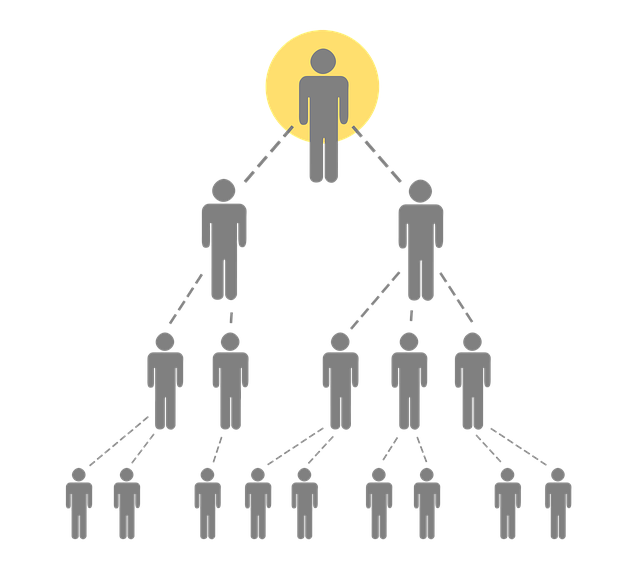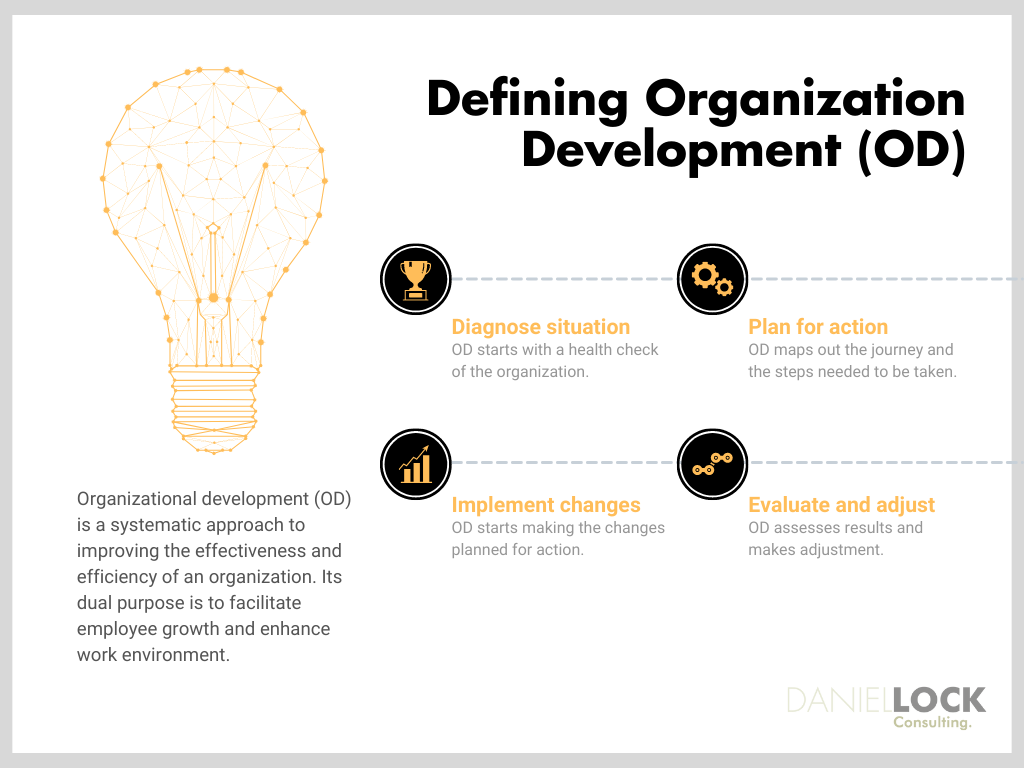Change management and organizational development. Two buzzwords you’ve probably heard. But what do they really mean? Let’s break it down.
Change management is all about guiding a business through specific changes. Think of it as a GPS for your company during a transition. It’s there to help you navigate.
On the other hand, the organizational development process is a bit different. It’s a holistic, long-term strategy. Its goal? To improve an organization’s effectiveness and health.
In a nutshell, change management is about the organizational process of managing specific changes. Organizational development, however, focuses on improving the entire organization. That’s the crux of it.
Stay tuned as we delve deeper into these concepts. We’ll explore their processes, roles, and key differences. Let’s get started.
Defining organizational development

Alright, let’s talk about organizational development: It’s a big-picture strategy. It’s all about improving your organization from the ground up.
Organizational development (OD) is a systematic approach to improving the effectiveness and efficiency of an organization. It involves analyzing and modifying business processes, strategies, structures, and cultures to enhance the organization’s performance and achieve its goals.

OD relies on the application of behavioral science principles to foster collaborative organizational culture and drive change. It aims at improving an organization’s capacity to handle its internal and external challenges in a rapidly changing business environment.
Key aspects of organizational development include continuous learning, data-driven decision making, participation and empowerment, team building, and fostering a culture of change. The ultimate goal of practicing organization development is to create a resilient organization that can adapt and thrive amidst constant change.
Exclusive blog bonus: Find out about my own change management model with my 30+ page FREE ebook, The Fundamentals Of Change Management
So, what’s the purpose of organizational development? Simple. It’s about enhancing organizational effectiveness. It’s also about the organizational development processes creating a better work environment.
But how does it work? It starts with diagnosing the current situation. Think of it as a health check for your organization.
Next, we move to action planning. This is where you map out your journey. You decide what steps you need to take.
Then comes the implementation of the new technology and the intervention. This is where the rubber meets the road. You start making the changes you planned.
Finally, there’s evaluation and feedback. This is your chance to see how you did. You assess the results and make adjustments as needed.
And what’s the role of organizational development in an organization? It’s about more than just making changes. It’s about facilitating employee growth and improving the work environment.
In short, organizational development is a long-term, holistic strategy. It’s about making your organization the best it can be. And that’s a goal worth striving for.
Differences between Change Management and Organizational Development

Let’s dive into the differences between change management and organizational development.
First up, scope: Change management is laser-focused. It’s all about managing specific changes.
On the flip side, organizational development takes a wider view. It’s a holistic approach. It’s about improving the entire organization. It is general closer to the strategic decision making fo the organisation. For example, in OD they would be thinking about the workforce planning to meet organizational goals several years into the future.
Next, let’s talk about focus. Change management is all about processes and structures. It’s like the architect of your organization.
Organizational development, however, is people and culture-oriented. It’s more like the life coach of your organization. It’s there to help your people grow.
But the organizational process aimed at development? It’s more collaborative. It’s about getting everyone involved. It’s a team sport.
Finally, duration. Change management is about the here and now. It’s short-term and immediate.
Organizational development, on the other hand, is in it for the long haul. It’s about long-term and continuous improvement.
Exclusive blog bonus: Find out about my own change management model with my 30+ page FREE ebook, The Fundamentals Of Change Management
In summary, while change management typically deals with managing specific, immediate changes, organizational development is more about the continuous improvement of the organization as a whole. Both are essential for an organization’s growth and success.
Change Management and Organizational Development are both crucial aspects of organizational transformation, but they have distinct focuses and methodologies. Here’s a table that outlines the differences between the two:
| Aspect | Change Management | Organizational Development |
|---|---|---|
| Definition | A structured approach to transitioning individuals, teams, and organizations from a current state to a desired future state. | A planned, organization-wide effort to increase an organization’s effectiveness and viability. |
| Focus | Primarily on specific changes, such as processes, systems, or structures. | Holistic approach, focusing on changing attitudes, values, and the culture of the organization. |
| Scope | Often limited to specific projects or initiatives. | Broader in scope, encompassing the entire organization or large parts of it. |
| Key Tools/Methods | Change models (e.g., Kotter’s 8-Step Process), stakeholder analysis, communication plans. Even AI tools. | Surveys, team building exercises, leadership development, system feedback. |
| Duration | Typically has a defined start and end, linked to a specific change initiative. | Ongoing, with continuous improvement and adaptation as key principles. |
| Primary Objective | Ensure that changes are smoothly and successfully implemented to achieve lasting benefits. | Improve organizational health and performance over the long term. |
| Key Stakeholders | Change managers, project teams, impacted employees. | HR professionals, senior leadership, all employees. |
| Resistance Management | Addresses resistance to specific changes. | Addresses resistance to cultural or systemic shifts. |
| Measurement of Success | Successful implementation of the change, realization of benefits, and minimal disruption. | Enhanced organizational performance, improved employee morale, and achievement of strategic objectives. |
| Role of Leadership | Change Leaders sponsor and support specific change initiatives. | Leaders drive the vision, values, and culture of the organization. |
It’s important to note that while Change Management and Organizational Development have distinct focuses, they can be complementary. In many transformational organizational improvement efforts, elements of both are necessary to achieve the desired outcomes.
Example and case study of organisational development and change management working together. Telstra: Sparking a Cultural Transformation

Consider Telstra, the Australian telco, a company that completed a cultural transformation in 2010 after CEO David Thodey took the helm. Telstra was facing the reality that the fixed-line business, once the cornerstone of their earnings, was facing imminent demise. After all, there were more mobile phones in Australia than people.
To compete in this new world of telecommunications, Telstra needed to move from engineering and “we own the pipes” mentality to that of what they called “customer advocacy.”
This is where both change management and organizational development are needed. A high level strategic change where the skills and make up of the organisation are reconsidered. This is the domain of organizational development. Whereas change management is about the tools and frameworks put in place to implement those changes.
From an OD perspective you can see the changes:
When it comes to a cultural transformation, first things first. Telstra started with their leadership. CEO David Thodey carefully outlined what “customer advocacy” meant for all levels of the organization and insisted the 300 top managers of the 40,000 strong employee base exemplify these behaviors.
The revamped reward and recognition programs and initiated one-on-one coaching and professional development plans to help staff along the journey is a classic change management play. But generally taking the direction on these large scope matters from the OD experts.
To be sure, not all stuck around. But Thodey pressed onward, confident that leadership alignment would be essential to the transformation.
Telstra made significant inroads, dramatically reducing referral to the telecommunication ombudsman by 26% and overall calls from consumers by 20% in the year or so that followed.
Although the company’s fixed-line revenue declined by 6.1% again the following year, Telstra added 1.6 million new mobile customers in the same period, bringing their total at the time to 13.8 million.
Conclusion
Alright, let’s wrap this up.
Change management and organizational development. They’re different, but both crucial. They’re like two sides of the same coin.
Change management helps you navigate specific changes. It’s your GPS during transitions. It’s about minimizing disruption and ensuring a smooth journey.
Organizational development, on the other hand, is your long-term strategy. It’s about improving your organization’s effectiveness. It’s about creating a better work environment and facilitating employee growth.
In the end, it’s not about choosing one over the other. It’s about understanding what each brings to the table. And using them wisely to meet your organization’s needs.
So there you have it. Change management and organizational development. Two powerful tools in your own organizational change toolbox. Use them well.


